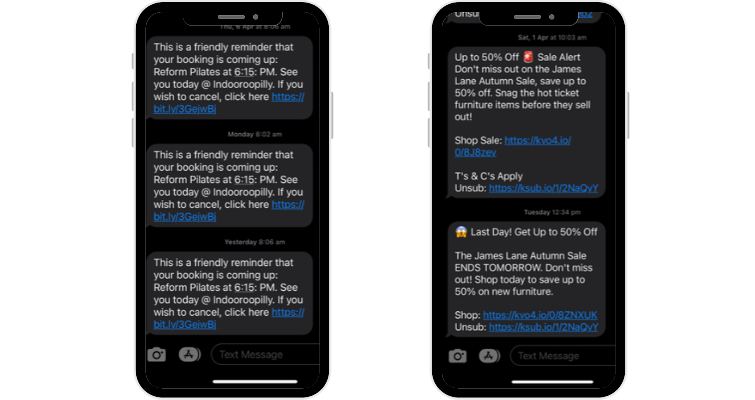We know you really want to get stuck in and make your sms marketing campaign stand-out; but before you press send on that VIP loyalty offer or your upcoming exclusive flash sale, you might want to touch up on the SMS Marketing Laws in Australia to make sure it’s legal.
Australia has some pretty robust SMS marketing laws and complying with them should be your first priority. In this article we’ll explore ticking all the consent boxes, and some prime examples of what to do and what not to do.
Before we get ahead of ourselves, let’s start with the basics.
How are SMS marketing laws governed in Australia?
When it comes to online marketing in Australia there are a number of governing laws and legislation that inform best practices.
The first one you need to be aware of is the Australian Consumer Law (ACL). This law essentially exists to protect consumers from being misled or deceived by businesses. To comply with the ACL, businesses must ensure that their content marketing is truthful, accurate and not misleading. So just remember, if you want to have a successful SMS marketing campaign it bodes well to be honest. No brainer right?
The second law relates to Australia’s privacy laws and it’s crucial for any business engaging in marketing a product or service especially now with our online landscape. The Privacy Act 1988 regulates how businesses collect, use and disclose personal information. So to comply with these laws, it is essential that you prioritise getting consent from individuals before collecting their personal information and/or sending them SMS marketin messages about your product or service.
The main SMS compliance laws we will be referring to in this article include the Spam Act 2003 and Spam Regulations. To keep it brief, these legislations reinforce the importance of having explicit consent before any SMS marketing messages are sent.
What are the rules for SMS marketing in Australia?
Consent consent consent! It’s as important as ever and takes the form of express and inferred permission which we’ll discuss below. However, let’s assume for now that you have a customer’s consent. What’s next?
The Spam Act 2003 outlines that once consent has been received and recorded your message must include the following three elements:
- You have identified yourself as the sender : your name and business name should be clear and readily available.
- The message contains your contact details : include any relevant information relating to your business and yourself.
- Customers can opt-out at any time : unsubscribing from your product or services should be easy and straight-forward.
Note: This includes messages from a third party sending SMS marketing messages on your behalf and in the name of your business. It must be clear that you’ve authorised the correspondence, use the correct legal name of your business, or your name and include your Australian Business Number (ABN).
Other rules to fight SMS scams
In July 2022, the Australian Communications and Media Authority (ACMA ) registered new rules to require telcos to identify, trace and block SMS scams. These new rules require SMS software providers like Vision6 to verify that you as a sender have the right to use alphanumeric sender ID. Alphanumeric Sender ID use alphabetical and numerical characters, instead of only numbers. Examples of include business names, brand name or organisations (i.e. Vision6, 1800Donuts, CoffeeShop).
It’s also important to note that alphanumeric sender IDs are not supported in some countries like New Zealand and the United States of America. If you do send to contacts in these countries using an alphanumeric sender ID your SMS will not be delivered.
If you want to see how to set up your Sender ID in accordance with the new rules laid out by ACMA check out our powersession recording.
How do I get consent for SMS marketing?
As mentioned earlier, consent comes in two main methods. You can read about them below and decide which one makes the most sense for your business, but to give you a hint, express consent is always a little more reliable than inferred consent alone.
Express Permission
Express permission or consent refers to individuals who know that they will be receiving SMS marketing from you and can look like filling in a form, ticking a box on a website and vocalising consent either over the phone or in-person.
Once you have an individual’s consent it is important to register this in a record detailing how, when and what (kind of consent) you received as it will safeguard you from any future complications. Remember! It is your responsibility to prove you have a person’s consent under the Spam Act 2003.
Inferred Permission
If you have prestated consent to be sending marketing messages to a recipient this falls under the category of what we call inferred consent.
An example of inferred consent might be someone who has subscribed to your business or service, they might be a pre-established member and have an account with you. Either way the messages they receive from you now and in the future are relevant to your business relationship and align with their potential needs.
It is important to distinguish that inferred consent does not cover marketing messages following a purchase. If you are using inferred consent it is important to make sure your SMS communications are strictly relevant and beneficial to your customers.
Provided that you work within these guidelines and SMS marketing laws when you start building your campaign, you’ll likely avoid some nasty headaches all while helping you establish loyalty and trust with your customer base. In short, sometimes it pays to follow the rules.
Pro-tip
Include the following elements in your consent records to make sure you’re covered:
- The timestamp of consent acquisition.
- The consent acquisition medium (i.e. pop-up, keyword, etc).
- The customer’s phone number for which consent to receive messaging was granted.
Why is SMS compliance so important?
As a business owner, it is your responsibility to keep your SMS marketing above-board and complying with SMS marketing laws in Australia. While it may seem like a hassle, here’s just a few reasons why SMS compliance is important:
- Safeguard you from any wrongdoing and hefty penalties
- Set your brand and business up for success
- Build a reliable and trustworthy image of your brand
Getting it all right might seem an impossible task but you can breathe easy with Vision6’ SMS marketing software and for information visit our compliance hub.
SMS marketing best practices to follow
Clear call to action
Being as perpetually online as we seem to be these days, a sharp and quick call to action is really the right way to go. Be clear and direct with your call to action but don’t be afraid to spice things up with an emoji or two.
Personalise it
Connecting with your users in a personal and intentional way is a sure fire way to keep customers interested. Sending SMS marketing messages that are consumer friendly avoids your SMS messages appearing spammy and unimportant. Two things we definitely don’t want.
Make it easy to opt-out
Just so we’re crystal clear, having an SMS opt-out in your SMS marketing campaign is essential. The Spam Act outlines these conditions for unsubscribing:
- unsubscribe button is clear and easy to find
- opt-out requests are actioned within 5 working days
- no payment fee is required
- unsubscribe button/ link works for at least 30 days after the SMS marketing message has been sent
- additional personal information such as logging in or creating an account is not required to process an unsubscription
Based on what we’ve talked about, let’s take a look at some real world examples. See if you can pick up on the good examples before we talk about why.
What to do and what not to do (with examples)
Good SMS examples

Left: This message it is a good transactional response that is clear, succinct and doesn’t include any additional marketing content; it includes the relevant customer information with a clear cancellation link.
Right: This is a good example of an SMS marketing message. In their SMS the urgent tone is balanced with appropriate use of emojis. The message remains very clear and highlights all the necessary info like the end of sale date and the unsubscribe link.
Bad SMS examples

Left: Did you notice what is wrong with this message? There’s no unsubscribe button and the company names used in the message are different. Missing these crucial elements makes the sender unclear and overall it reads like spam.
Right: It’s probably quite obvious for this one. This SMS from Telstra reads more like a highschool break-up text than it does an SMS marketing message. A big chunk of text like this, with obscure abbreviations, run-on sentences and difficult opt-out process…thank-you next.
Conclusion
You know the basics of SMS marketing laws in Australia, now you need to put them into practice!
If you’re still not convinced, Vision6 is here with our practical tutorials, guides and handy tricks to help you perfect your online marketing campaign the legal way.






